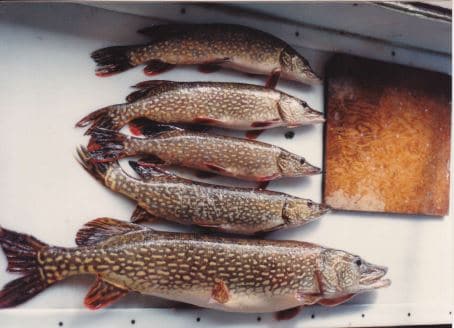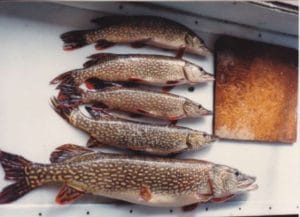
I am a huge fan of pike fishing, but it does require a little bit more planning than your average fishing trip. You can’t just grab your fly fishing net, a carton of worms, and your 5-foot fishing rod that has 6-pound test line on it and hope to catch big pike! It’s not going to end well.
Basically, if you don’t have the right northern pike fishing gear, you are going to have some difficulties catching quality northerns!
We wanted to give you a quick breakdown of the different northern pike fishing gear you should have for your next big fishing trip – and also our tips on what to look for in good pike fishing gear.
Hopefully, this list will help you stay organized and allow you to have all the appropriate gear you need to make your next pike fishing trip successful!
Table of Contents
Pike Fishing Rods
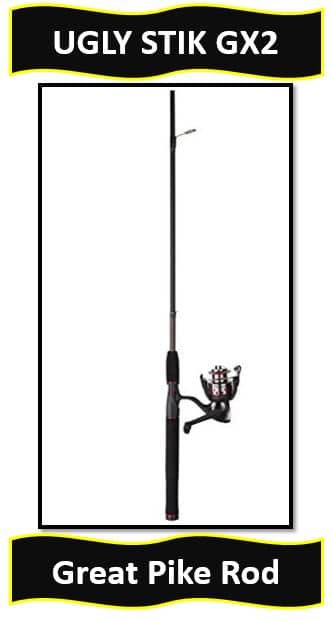 If you are going to be fishing for large northerns, you got to make sure you have a fishing rod that can handle the major impact these fish have when striking a lure. A small ultralight rod could break in half, or at least give you a major work out when trying to catch this species of fish!
If you are going to be fishing for large northerns, you got to make sure you have a fishing rod that can handle the major impact these fish have when striking a lure. A small ultralight rod could break in half, or at least give you a major work out when trying to catch this species of fish!
There are a lot of different companies that make great pike fishing rods – the key is making sure you pick a fishing rod that meets specific criteria. Here are some of my tips on picking the best pike fishing rod.
Tip #1 – I prefer a fishing rod that is Medium Heavy. I want a fishing rod that has enough strength to handle northern pike & enough backbone to really set the hook. I also want a fishing rod that is light enough to easily handle, and has good action. To me, that is a Medium Heavy rod!
That doesn’t mean you can’t have really good success with a Medium or Heavy Rod. I have a Heavy rod that I use when I’m trolling or hunting for big pike, and I have a Medium rod I use often for crankbait fishing.
But to me, the perfect balance of action and power for pike fishing comes in the form of a medium heavy rod!
Tip #2 – My ideal pike fishing rod is going to be a 6 ½ foot rod. That is a large enough rod that you have the strength you need to handle pike – and the sensitivity you want to feel the action of your lures. Longer rods can be a little harder to handle – especially for kids – so that is always a factor to keep in mind as well.
It is not uncommon to use a 6-foot or 7-foot rod when pike fishing. Both of those also have a nice combination of sensitivity and power. I don’t normally recommend fishing rods that are larger or smaller than that size for pike fishing.
Tip #3 – The age-old question is should I use a one-piece fishing rod or a two-piece fishing rod? I prefer a one-piece fishing rod. I feel a one-piece rod has more strength to it and I like the action better than when compared to a two-piece rod.
The benefit of a two-piece rod is they are obviously a lot easier to transport. One-piece rods can be a pain to travel with. A broken rod doesn’t do anyone any good, so if you need to, make sure you travel with a two-piece rod.
Other Things to look at – Other things you may want to look at are picking a fishing rod that is cool looking – I mean, lets fish with style. I also prefer a cork handle over a foam handle – but these things are all a matter of personal preference.
Some of the most popular fishing rod manufacturers for pike fishing are going to include:
If you are looking for a complete review & list of some of the best pike fishing rods, check out our article on “Best Northern Pike Fishing Rods.”
Pike Fishing Tackle
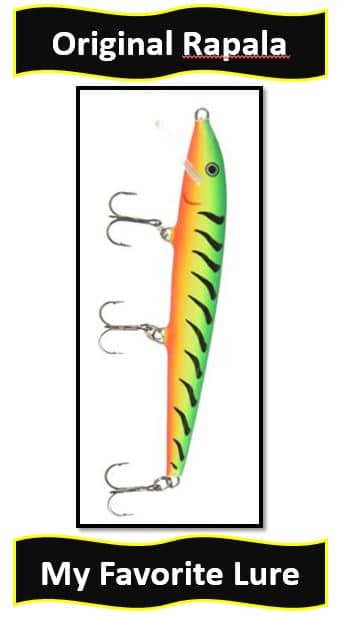 Obviously, fishing for pike with the wrong tackle is going to make it pretty difficult to catch one. There are a lot of different fishing techniques and tackle that can be used, but there are some basic tips and basic tackle that tends to work really good for pike fishing!
Obviously, fishing for pike with the wrong tackle is going to make it pretty difficult to catch one. There are a lot of different fishing techniques and tackle that can be used, but there are some basic tips and basic tackle that tends to work really good for pike fishing!
Tip #1 – Pike are an aggressive, predatory fish. That means using a lure that mimics fish they feed on, or an injured fish in general, can trigger that predatory instinct and lead to big hits! Lures like floating Rapalas, Bomber Crankbaits, Jerkbaits, and Rattle traps can trigger that instinct!
Tip #2 – I have also had great success using lures that are shiny & reflective in the water. You can really catch a pike’s attention with the gleam of a shiny gold or silver lure. Spoons, jerkbaits, and crankbaits can really create that shiny commotion in the water that drive pike crazy!
Tip #3 – When pike fishing, lures that make noise are a good thing. There are lots of different lures that include rattles and other noise making options. This is another way to garner a pike’s attention – leading to those big hits. The Northland Buck shot rattle spoon, Heddon Super Spook, and Rat-L-Traps are great examples of lures that use noise to their advantage.
Tip #4 – Guys you may not want to hear this (terrible joke) – but size does matter when you are pike fishing. When you are hunting for large northern pike, you want to use bigger lures. You want bigger crankbaits, bigger spoons, bigger spinners – large northern are looking for large meals.
Tip #5 – You may see a common theme in the above-mentioned tips – lures that cause a racket tend to be successful. Lures that are large, shiny, noisy, mimic injured fish – basically lures that do lots of different things to get a pike’s attention – are going to be the most successful.
There are many different fishing techniques that you can use to catch pike, including jigging, trolling, and casting. They all require slightly different tackle, so make sure you are properly equipped for the type of fishing you will be doing!
Popular Pike Fishing Tackle includes:
- Rapalas (My Personal Favorite)
- Rat-L-Traps
- Spoons
- Jerkbaits
- Jigs
- Spinnerbaits
If you want even more specific recommendations on different northern pike fishing tackle options, check out this article we did on the “The Best Northern Pike Fishing Lures.”
Pike Fishing Line
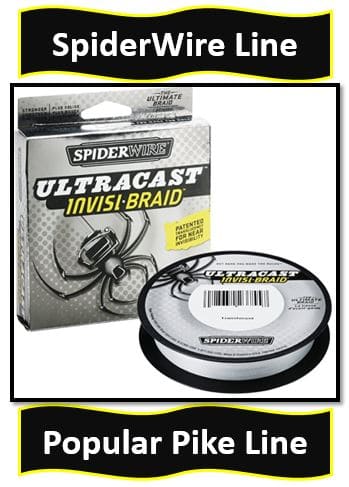 Pike fishing tackle can get expensive, so we really recommend not losing your pike lures. This is a two-part process – using a wire leader (we will cover that in a little bit) & using the right type of fishing line. Here are my tips on picking the right pike fishing line.
Pike fishing tackle can get expensive, so we really recommend not losing your pike lures. This is a two-part process – using a wire leader (we will cover that in a little bit) & using the right type of fishing line. Here are my tips on picking the right pike fishing line.
Tip #1 – I can’t stress this enough – don’t go pike fishing with regular monofilament line tied right to your lure. You are going to get pretty frustrated when pike keep lacerating your line, and that expensive tackle starts to disappear quickly.
You can use monofilament line if you attach it to a wire leader. A wire leader is going to help prevent your line from getting cut.
Most anglers prefer a monofilament type of fishing line because it is going to be easy to cast, and it has a nice give to it, which really helps the action of your lures.
Tip #2 – Pike can be big – so leave that 6-pound bass fishing test line at home. Make sure you use the appropriate strength of line. When you are using monofilament line attached to a leader for casting lures, 10 – 16 pound test line should be strong enough to hold the majority of pike. If you are trophy hunting, you might want to kick it up a notch or two.
If you are trolling crankbaits or other lures, you are going to want to be in the 16 – 20-pound range for monofilament line. You are going to want that little extra strength.
Tip #3- When you need to tie your line directly to a lure to get the appropriate lure action, braided line can be successful. Unlike monofilament line, braided line has extra strands weaved into it to give it extra strength – making it much more difficult to get cut by those sharp northern pike teeth.
Braided line can seize up a little bit and be more difficult to cast, but the added strength is a major benefit when pike fishing. There are many anglers that swear by this type of line.
Tip #4 – When pike fishing, you don’t need to worry about having a fishing line that isn’t visible when in the water. Other species of fish are often turned off by seeing the actual fishing line and will refuse to bite. Pike aren’t really picky – if your lure gets their attention that predatory nature kicks in, and they are going to strike.
Line strength is going to be more important than line visibility.
Let’s make sure we protect your tackle – pick the right type of fishing line! Here are a few options of very popular fishing lines used when going after pike!
Pike Fishing Wire Leaders
 If you read anything in the above section about pike fishing line- you should know that you are going to want a wire leader for almost all fishing techniques you are going to be using when you are pike fishing. Here are some tips on what you should look for in a wire leader.
If you read anything in the above section about pike fishing line- you should know that you are going to want a wire leader for almost all fishing techniques you are going to be using when you are pike fishing. Here are some tips on what you should look for in a wire leader.
Tip #1 – Size is important, and almost all people agree that a 12-inch wire leader is perfect for pike fishing. This is long enough to prevent a pike’s teeth from reaching your line, which is going to prevent your line from being cut!
A 6-inch wire leader is sometimes necessary for top water lures and lures that have a certain action to them. An 18-inch wire leader can be used as well, but they can sometimes make casting a little more difficult.
Tip #2 – Most anglers would also agree that a 20 or 30-pound wire is also perfect for pike fishing. We aren’t really worried about a large northern cutting your wire leader in half with their teeth, so you don’t have to go crazy and buy a super thick option.
Tip #3 – Wire leaders can negatively impact the action of a lure – so make sure you pay attention when using one.
Tip #4 – I personally don’t think the color of your wire leader matters much, but most people will recommend either black or silver based on their personal experiences.
Tip #5 – It is not as important to use a wire leader with certain fishing techniques. When trolling or doing a fast retrieve with a lure, it is less likely that a northern pike will engulf your lure, and if you lure isn’t engulfed, you reduce the chances of those sharp teeth cutting the line. Larger lures also reduce the risk of being inhaled – which again reduces the chances of your line being cut. I can’t promise your line won’t get cut without a wire leader using these techniques, but it just reduces your risk.
On the flip side, techniques like jigging should always be used with a wire leader because those lures are going to get smashed, increasing the chances of your line getting cut.
Here is a list of some good northern pike wire leaders – there are a lot of different ones to pick from – as well as a complete article we did on wire leaders for pike fishing called “Quick Hitter: The Best Wire Leaders for Northern Pike Fishing.”
Pike Fishing Nets
 Now that you have the appropriate rod, fishing line, wire leaders, and tackle – you are going to need to be able to net your large northern pike. It is not a good idea to use a very small net for this – it won’t end well for you most of the time, and you really shouldn’t be sticking your hands into the water to pull out a northern either. So with that being said, here are some tips on how to pick out a good northern pike fishing net.
Now that you have the appropriate rod, fishing line, wire leaders, and tackle – you are going to need to be able to net your large northern pike. It is not a good idea to use a very small net for this – it won’t end well for you most of the time, and you really shouldn’t be sticking your hands into the water to pull out a northern either. So with that being said, here are some tips on how to pick out a good northern pike fishing net.
Tip #1 – Get a net that has a large enough hoop size to scoop up a northern! Pike are a very long, and slender fish – so your net must have a big enough hoop to fit the entire fish inside of it.
Tip #2 – I am also going to recommend having a net hole/mesh size of 1-2 inches for a northern pike net. The reason you want larger holes is because this will reduce your water resistance, making it much easier for you to move the net in the water to capture your large pike & also make it much easier for you to scoop the pike out of the water. It isn’t as easy as you think to scoop up a 15-pound pike.
Tip #3 – I also recommend picking a net with the appropriate handle length and material. For material, I normally recommend a durable aluminum or fiberglass material because they are lightweight, easy to handle, and comfortable in the hand.
For length, the best advice I can give is shorter nets are easier to maneuver, but you have to be close to the fish – longer handles are better for bigger boats and choppy waters where you need an extra reach.
Tip #4 – There are many different netting materials you can pick. Coated nylon and rubber are what I normally recommend because the help protect the fish and they help prevent your lures from being snagged inside the net. Non-coated nylon nets can scrap off scales and remove the protective slime off of fish – so they aren’t as good for catch and release fishing.
The other non-science based tip I hear from time to time is nets that have a black mesh are less likely to spoke the fish. I have no idea how accurate that is, but my older fishing friends swear by it.
Here is a list of some really good northern pike fishing nets that you can purchase, and if you want a full review on these nets I would recommend taking a look at our article: “Best Nets for Northern Pike Fishing.”
Pike Safety Equipment
 Once you catch a large northern pike, you want to make sure you stay safe while removing your lure and handling the fish. We often overlook having some of these pieces of pike fishing gear with us, so make sure you check your tackle box before going on that big fishing trip.
Once you catch a large northern pike, you want to make sure you stay safe while removing your lure and handling the fish. We often overlook having some of these pieces of pike fishing gear with us, so make sure you check your tackle box before going on that big fishing trip.
Fishing gear you should have when handling pike includes: jaw spreaders, pliers, bolt cutters, and gloves!
Tip #1 – Having a good pair of jaw spreaders is going to help you remove your tackle from a pike’s mouth without the fear of those sharp teeth closing on your hand. Jaw spreaders are spring loaded, are placed into the mouth, and prevent the jaw from closing. Definitely something you want when handling big pike.
Tip #2 – This should be common sense, but you are also going to want a good pair of pliers. Don’t stick your fingers inside a pike with lots of sharp teeth. Use your pliers to remove the hook from the mouth, and to retrieve your lure. This is especially important when you are using crankbaits or treble hooks that can be a little more difficult to remove. Here is a great article on different fishing plier options!
Tip #3 – A good pair of fishing gloves is going to help protect your hands from being cut, and help you grip a very slippery fish. I wouldn’t call fishing gloves an absolutely necessary piece of equipment, but they certainly help protect your hands – which is why I use them! Here is a great article we did on the best fishing gloves you can buy!
Tip #4 – Probably the piece of equipment that we forget about the most is a pair of bolt cutters. You may never have to use this piece of equipment, but if your lure gets inhaled, I mean swallowed way down in the pike’s mouth, this is where you are going to need bolt cutters.
Bolt cutters can be used to cut the hooks as close as you can to the point of contact, and allow you to pull out your lure. Removing the lure is good for the fish – especially in those catch and release situations.
Having these 4 pieces of equipment with you will make sure you keep your hands safe – and if you are practicing catch and release fishing practices – it will help keep the fish healthy too!
Final Wrap Up
Pike fishing trips do take more planning, and the fishing gear can be a little more expensive than your fishing gear for other species – but it is well worth the cost and planning! I still have incredible memories of the pike fishing trips I took to Canada and the upper Midwest of the United States!
Pike provide a unique mixture of power and aggressiveness – and provide a unique angling experience you can’t get with most species of fish.
So, if you have never been pike fishing, we are going to encourage you to go a few times so you can experience all the fun. If you go pike fishing a lot, we understand why you are addicted to it!
Hopefully this list of pike fishing gear will help make your next pike fishing trip as successful as possible!
As always, if you have some great gear suggestions that we don’t have listed, or if you just have a great northern pike fishing story that you would like to share – please let us know! We love hearing from our readers!

